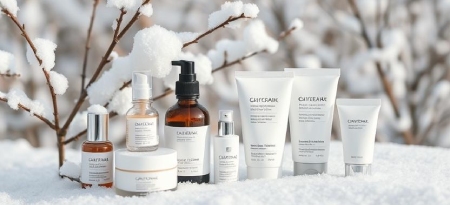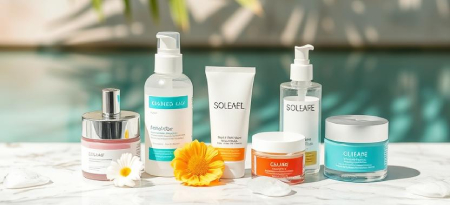Canadians know that their climate can be very harsh on their skin health. The freezing winter season that sets in each year often gives way to hot and desert-like summers from one region to another. The climate in Canada presents highly challenging variations depending on the area. It can really strip the skin of its natural barrier, which is essential for healthy skin. Skin care in severe conditions should include a regimen, lifestyle changes, and awareness of how natural environmental and social factors can damage the skin. This feature provides real-life tips for building a routine to protect and nurture the skin all year round, ensuring that no matter the season, the skin remains healthy, hydrated, and radiant.
Impact of Harsh Canadian Seasons on Skin
Some of Canada’s coldest weather can include a surprising cold wind from dry areas when the sun shines perfectly. Skin is the part of our body that faces the most changes and is exposed to extreme dryness. Many times, skin that becomes out of balance can become dry, sensitive, cracked, or similar issues. But why worry about tearing, when it could mean more than that? First, understand how each season truly impacts the skin.
Winter’s Dry and Freezing Conditions
In Canada, extremely cold temperatures are common, along with increased wind that can dry out the skin, causing dryness, irritation, redness, and weakening of the moisture barrier. Indoor heating can worsen dryness, leading to dull, rough skin unless properly cared for.
Summer Heat and UV Exposure
It’s reassuring to see how these factors perfectly align in a nearly flawless description. Imagine a negative weather shift for dry skin: Wind and cold can sharply increase skin sensitivity, and it’s important to remember how icy the world appears when shivering, which can cause the skin to crease. Winters tend to bring excessively dry air due to this characteristic lack of humidity. As a result, the skin becomes less elastic, and wrinkles continue to develop on the face.
Essential Skincare Tips for All Seasons
This is more of a fundamental approach to skincare focused on hydration and protection year-round to maintain healthy skin. This section covers basic principles of skincare that are especially relevant throughout the seasons.
Consistent Hydration
Help improve skin resiliency locally by increasing your water intake before applying any moisturizer for the changing seasons. Creamy formulas containing ceramides, glycerin, and hyaluronic acid at high levels are recommended for winter, while lighter, non-comedogenic lotions are better for summer to prevent pore blockage and replenish what’s lost.
Sun Protection Every Day
Protect your skin from UV rays all year long. A regular sun protection routine helps prevent inflammatory irritation. Use a daily broad-spectrum SPF 30+ sunscreen; reapply every two hours if you’re outside for work. Wear protective clothing, hats, and sunglasses to guard your body from further ultraviolet damage.
Tailored Skincare Routine for Winter

Cleaning cracked sebum can create a breeding ground for bacteria, which could lead to acne. These cleansing practices might also wash away dead cells from your skin surface.
Gentle Cleansing
The best way to cleanse skin varies with the season. This part explains why gentle and moisturizing cleansers are ideal for the dryness that winter brings. Cold weather requires gentle cleansing. It’s better to use mild cleansers that retain moisture; such products remove impurities without stripping away natural oils. Additionally, avoid using very hot water, as it dries out the skin and causes irritation.
Nourishing Moisturizers and Treatments
If someone wants to look pretty even during winter, they should take care of their skin. Therefore, some of the best ways to do proper winter skincare are by using plenty of nourishing products, since they contain many substances that help prepare and protect the skin. It’s important to stay updated on skincare and maintain elaborate routines to ensure that the skin remains in the best condition possible.
Summer Skincare Focus

This time of year calls for more sweating, sun exposure, and a generous layer of sunscreen to keep you cool. This site will focus on small changes you need to make to your skincare routine to keep it fresh and healthy during the summer.
Lightweight Hydration and Oil Control
Staying hydrated without making your skin oily is important, especially during summer. Lighter moisturizers are not thick and contain ingredients that make your skin feel light, fresh, hydrated, and soothed. Skin tends to produce more oil when it gets warm outside. Switching to a light gel-type moisturizer helps balance hydration without feeling heavy or greasy. Natural ingredients like aloe vera and green tea extracts are excellent for calming the skin and reducing inflammation.
Thorough Sun and Environmental Protection
When skin cells are exposed to sunlight during summer, they undergo oxidative stress. This section discusses sun avoidance strategies and post-exposure skin care. In addition to using sunscreen, sun exposure should generally be avoided during peak hours—from 10 a.m. to 4 pm—because this is when UV rays can strain the skin. After exposure, gentle cleansing followed by antioxidant serums helps prevent free radical damage and supports skin repair.
Additional Lifestyle Factors Supporting Skin Health
The skin’s wellness goes beyond topical treatments and includes other factors like daily routines and environmental exposure. The latest section also looks at aspects such as lifestyle choices and nutrition, which play a key role in the immunity and resilience of healthy skin.
Balanced Nutrition and Hydration
Clear, bright skin is a healthy external sign of good nutrition and hydration. Proper nutrition and hydration are essential for healthy skin, and this article reviews dietary recommendations for improving skin from the inside out. While an antioxidant-rich, vitamin-filled, and healthy fat diet supports skin health, skin quality can be compromised without such a diet. Focus on essential nutrients found in fruits, vegetables, nuts, and oily fish to help protect skin from environmental stress.
Avoiding Harsh Habits
Certain habits can damage the skin, especially in extreme climates. How do you protect your skin barrier and create a skin-friendly environment at home? To avoid damaging your barrier: steer clear of hot water, harsh exfoliation, and excessive use of drying products, such as limiting hot showers, harsh scrubs, and overusing darkening agents. These are the areas to focus on in your living space; humidifiers help maintain indoor moisture during winter and add hydration to dry air for healthier skin.
Summary
Maintaining a radiant complexion throughout Canada’s harsh seasons requires a comprehensive approach that addresses the unique cold and hot challenges of summer and winter. Winter’s cold weather strips away existing dry skin, damages the epidermis, and breaks down the moisture barrier. Meanwhile, summer’s intense sunlight and humidity further expose your skin to dehydration and excess oil. Key to maintaining healthy skin is staying hydrated, protecting yourself from the sun daily, and adjusting your skincare routine according to the season—using gentle cleansing and moisturizing in winter, and opting for light hydration with thorough sun protection during summer.
The mission is well-supported for skin health through balanced, engineered nutrition, daily water intake, and avoiding harsh habits and lifestyles, thereby supplementing other methods to maintain renewal each season. The skin is cared for. Let these simple steps work magic for your skin’s freshness and nourishment all season long.

